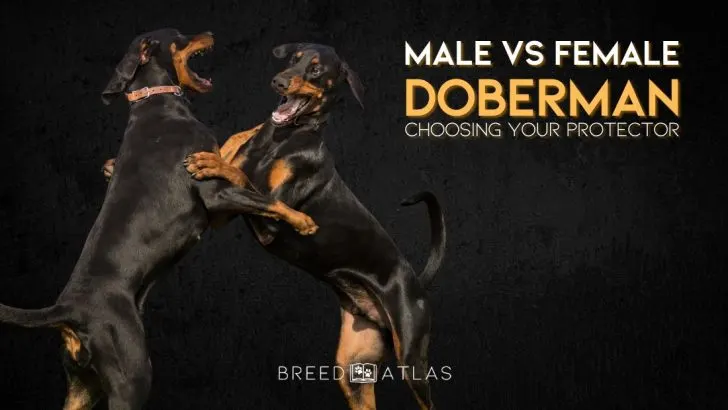When describing a perfect dog, one might use words like energetic, watchful, determined, alert, fearless, loyal, and obedient. If you look into the male vs female Doberman dog breed standard, you will find all those words under temperament.
If you wonder if a male or a female fits your lifestyle better, please note that the individual character is more significant than the sex. However, differences between lady Dobermans and their male counterparts can be found and generalized.
As we can notice in all other breeds, the males are taller and heavier than the female Dobies. During their early age, males are more prone to playful and silly demeanor.
The boys are usually much more territorial, while the gals are alert around unknown people. All these behavioral variations later play a role in training and social interactions.
To end this ongoing discussion of the male vs female Doberman, I compiled all the meaningful differences in one comprehensive guide to help you make a better choice for your family dog.
Male vs Female Doberman Overview
| Height | Weight | |
|---|---|---|
| Female | 24-26 inches | 60-90 pounds |
| Male | 26-28 inches | 75-100 pounds |
| Lifespan | Temperament | |
|---|---|---|
| Female | 9-12 years | Serious, alert, less stubborn, cleaner overall |
| Male | 9-12 years | Playful, goofy, attention seeking, less likely to get along with other dogs |
Dobies 101
The formidable Doberman is one of the more popular breeds in the world. This breed was established in the 1980s in Germany by Louis Dobermann. He was a tax collector who wanted to create a dog for personal protection to accompany him on his runs.
Nobody knows which exact breeds Luis used to create the Dobie. However, the experts assume that Rottweiler, German Pinscher, Great Danes, German Shepherd Dog, and the Manchester terrier all played a role.
The final result was this gorgeous breed that excels as a guard dog, sports dog, and family pet. In the past, Dobies were used as working dogs in the police and military. Some of them even being service dogs.
Today, with the continued breeding to help socialize the breed, they are family pets who love their owners like no other breed out there.
This high-energy dog requires regular mental and physical stimulation, no matter the sex.
If we consider Doberman guarding genetics for a second, it will become clear they need daily training and socialization from an early age. That will help them to be stable and well-functioning dogs.
Genetics, in every breed, plays a big role in the behavior of the pup. We can notice some distinct differences between the girls and the boys.
Those differences can and should affect your decision on whether to bring a female or a male dog home.
So what are they?
Visual Differences Between The Male vs Female Doberman
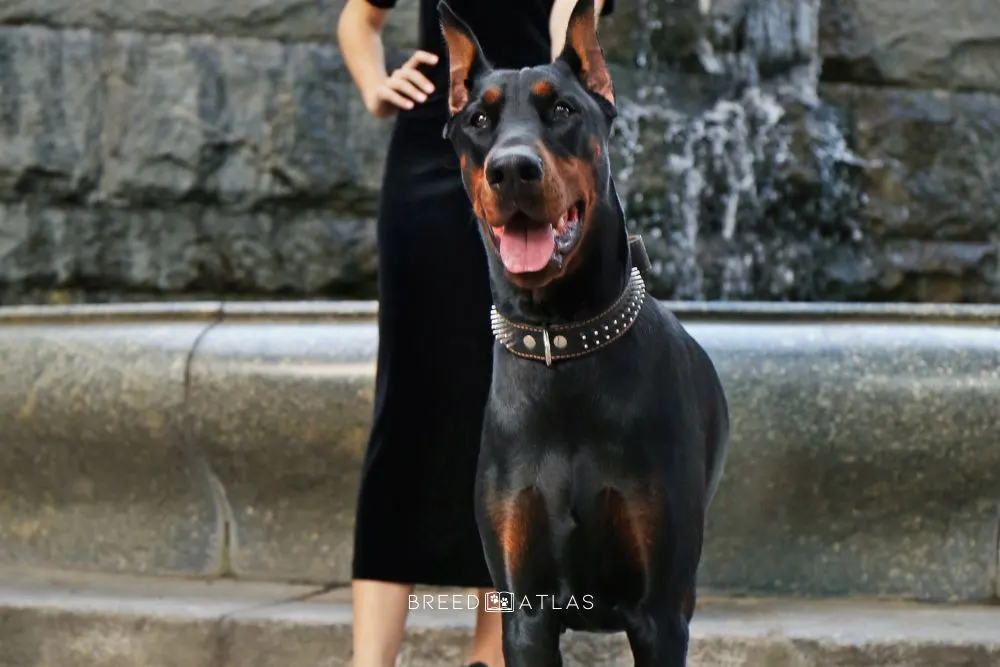
When someone says Doberman, the image in our head is one of a sleek and powerful dog.
They have a well-muscled and athletic body with a short, shiny coat. Their coats can be black with rust markings or brown with rust markings.
The head is long, featuring a specific wedge shape with a flat skull. Their ears are frequently cropped, to stand upright, contributing to their watchful and focused expression. The tail is frequently docked, leaving a short, tapered extension.
Overall, the Doberman exudes strength, elegance, and a sense of alert intelligence.
The Girls
Something that may not be that noticeable in pictures, but apparent once seen in person, the girls have a much more elegant look, with a smoother coat.
The smaller size, when compared to the male dogs, also adds to their undeniable elegance.
If we take a look at the AKC standard, it states that the ideal height for an adult female is 25 inches. 24 and 26 inches are also acceptable, so you have a pretty good idea of how big your new buddy gets.
The ideal weight for this dog is from 60 to 90 pounds, depending on other physical traits like height.
The Boys
As is the case with most breeds, the males have more hard angles than their female counterparts. Due to more muscle mass, the males are also on the larger size end.
If you observe the head closely, you will notice it is a bit bulkier than the females. The average height for a mature male is from 26 inches to 28 inches. The average weight is anywhere from 75 pounds to 100 pounds.
Temperament And Personality
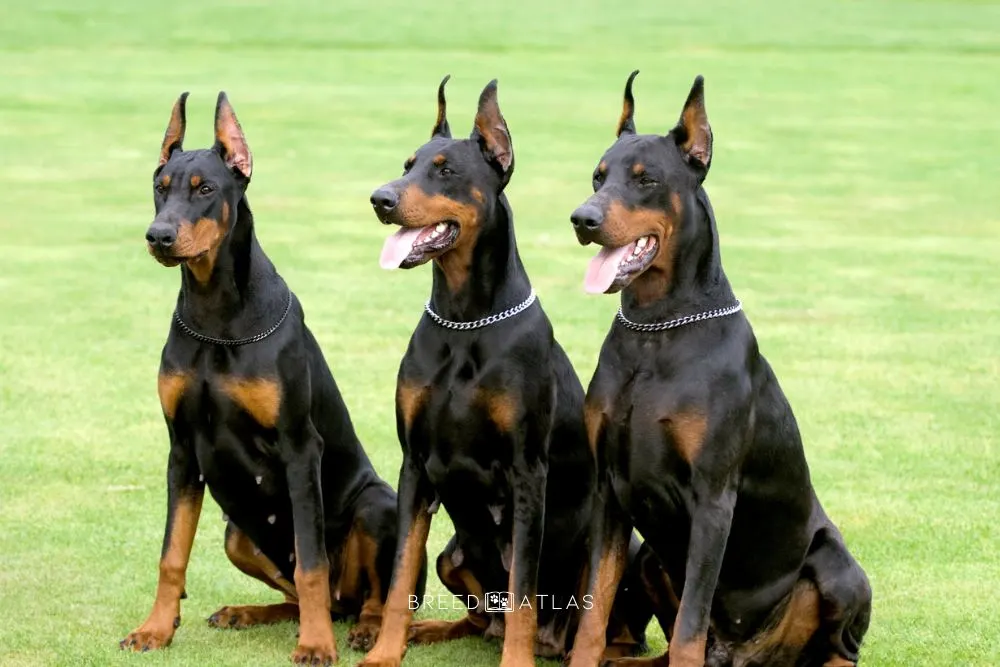
As mentioned in the beginning, the Doberman has a terrific temperament for those who know how to handle it.
This working dog breed is quite handler-oriented, and if trained and socialized in the right way, they can be very caring and endearing with people in general.
These loyal goofballs can be wonderful companions for little kids if raised with them from a young age. While these dogs love all family members, they do play favorites.
You might have heard that Dobies are one-person dogs, and it’s true. Not all, but Dobermans usually bond with one person.
Now let us dive into the specifics of male vs female Doberman personality differences.
The Girlies
Just as is the case with us humans, the females of the Doberman breed reach maturity sooner than the males. It happens when they are about two years of age, making them a good choice for someone who was not a previous owner of the breed.
They are often easier to potty train and can be left alone earlier than the males, who might exhibit destructive tendencies in the same situation. Dobermans as a breed, usually don’t have a problem with separation anxiety.
Females are more wary of strangers, and they are the ones who form a closer bond with one person, making males a better choice for people with children.
The good thing about them is that they have higher emotional intelligence than the males and can sense your emotional state. That means when you need love and cuddles – the girls will be all over you, and when the need for space arises – that is what you get.
But the girls sometimes get in a mood themselves and can be quite a challenge to handle during the heat cycle.
Spayed Girlies
Some behaviors might be different when your female is spayed. You won’t have to worry about them roaming and running away, which happens during their heat cycle.
Eliminating the hormonal changes means they will not express moodiness, and you won’t have to deal with bloody discharge on your furniture every six months.
The Boys
When talking about male vs female Doberman temperament, the boys are preferred in the Dobie community.
They are much friendlier to strangers, often engaging in play very soon after meeting the person. Their goofy personality and playful nature become much easier to manage when they reach four years of age. That is the age when the males of the breed reach maturity.
Much messier and clumsier than the girls, they need clear direction from the owner as they can be headstrong and stubborn. They are the best choice for owners who have a lot of time to devote to their dogs because the boys loooove attention.
They are ready to jump on you every forsaken time you look away and give attention to something else. When left alone, they can show some destructive behavior coming from boredom.
The male Doberman usually doesn’t get along with males of any other breed. However, neutering the males is a way to alter some of the behaviors they display.
Neutered Boys
Keep in mind that this is not a way to change their essential personality. However, some differences can be noted and talked about.
The pesky disposition to hump objects, people, and other dogs should lessen. If they display aggressive tendencies, they should be decreased, but you should consult a dog trainer as well. Their high-strung need for activity will be reduced, and their appetite can increase.
Training Differences In Male And Female Doberman
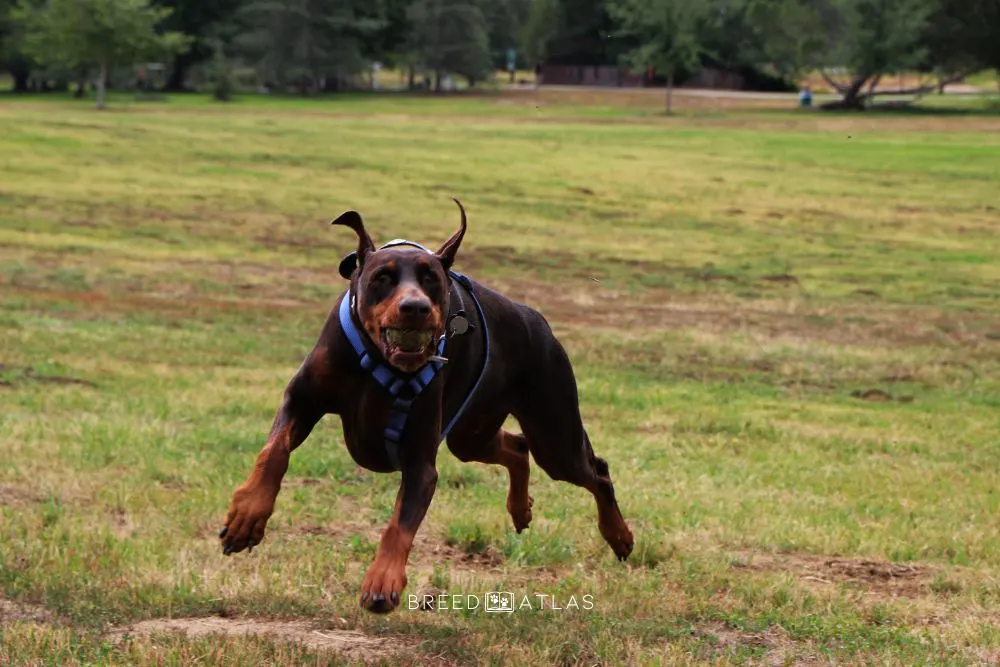
This breed is sorted in the working group by the AKC. That means that Dobermans are bred to perform practical tasks, as opposed to just being pets. They need early training, and it has to be consistent.
Thankfully, all of you who can not envision yourself doing dog sports, or other working tasks with your dog, choose a show line Dobie.
Show lines are bread as an example of the breed that conforms to breed standards. They usually have a bit less energy and craziness than the working lines.
As mentioned earlier, Dobies aim to please their owners and are very handler-oriented, making training sessions easier with this intelligent breed.
They are powerful dogs, full of drive and energy and they need a lot of exercise and regular training sessions. If this breed is not adequately trained and exercised, they are more likely to become aggressive.
Thorough socialization and obedience training from a young age are necessary for this breed. The Doberman responds beautifully to positive reinforcement, as does almost every dog.
If you envision your Doberman as a family protector, experts advise against special guarding training. They believe additional training, with only that goal in mind, can result in overguarding and aggression.
There are slight differences in the trainability of the two sexes, so allow us to analyze them closely.
Female Dobies
The females of the Doberman breed are uncomplicated to train, thanks to the fact they reach maturity much sooner than their male counterparts.
They make potty training a picnic, and if you work longer hours, the female requires less care when left alone.
If you wonder what makes females more trainable, the answer has already been talked about earlier. They have an excellent ability to tune into the emotions of their handler.
That skill, combined with the fact that they form a close bond with their first owner over the whole family, makes them extremely ready to please the owner and respond well to commands.
But beware, they are eager to please just that one person they bond with, others not so much.
The girlies respond much better to verbal praise and light corrections during training sessions. Another big plus for the females is that they are not nearly as distractable as the males.
If we think about recall or off-leash training, the females make it much easier to achieve. With proper training, you won’t have problems with them running toward other people or animals.
Don’t get me wrong, the girls are not perfect. But for novice owners, they might be the right choice.
Male Dobies
The boys remain childlike for years, and that might be a problem during training.
The potty training part is a headache with the boys. They often mark their territory outdoors and indoors and need close supervision during the puppy period.
Their attention is hard to keep, and they love to sniff and run around. If you want to make training easier, for yourself and the dog, you have to figure out their biggest motivator.
Some Dobies would do anything for a piece of beef, and some for a ball or a tug. While training your dog, you must recognize what gives the best results.
Thanks to the fact that this breed is highly competent and intelligent, once you figure out how to keep the focus of your dog, the training results won’t be far behind.
Male vs Female Doberman – Health
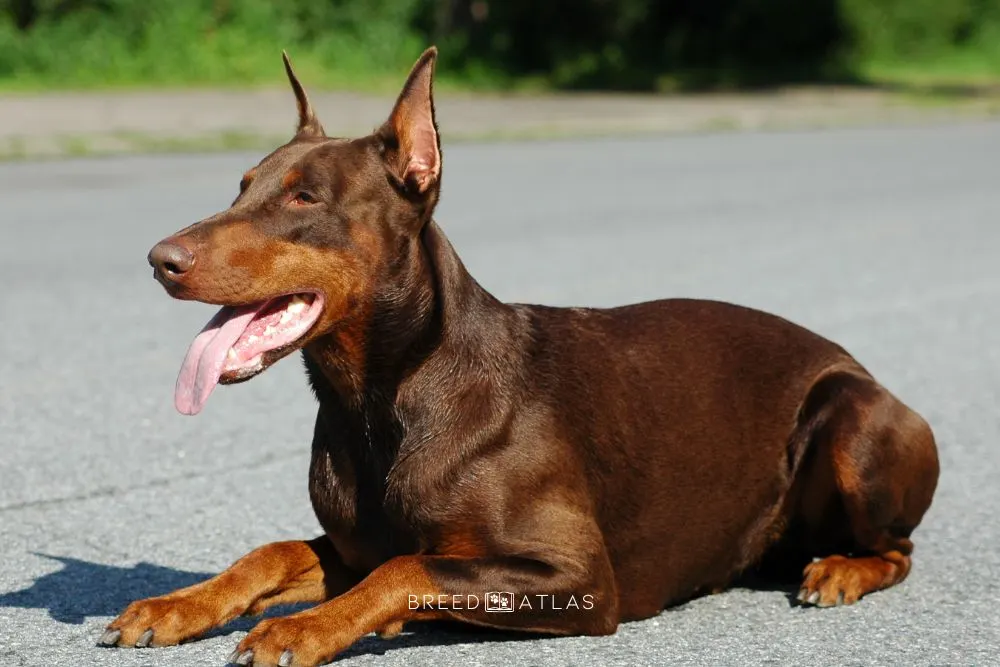
Dobermans live from 9 to 12 years in general. They are prone to some genetic issues and might be costly to own and treat if they develop them. That is why good breeders are of vital importance.
An ethical breeder will always health test their dogs and minimize the chance of producing a dog that isn’t healthy. Thanks to the ability to follow healthy breed lines, some real issues are avoided.
Let’s talk a bit more in detail, about the genetic plagues that can bother your best friend.
Von Willebrand Disease
Von Willebrand Disease (vWD) is a hereditary blood illness that is seen in Dobies more often than in other breeds.
When a dog doesn’t have enough Willebrand Factor (vWF) proteins, he can’t form blood clots. So if the dog hurts himself and is bleeding, he won’t be able to stop.
While the main symptom includes excessive bleeding, others are blood in the excrement, blood in the urine, bleeding nose, blood from the mouth or gums of the pooch, bruising varying from small to quite large, anemia (bad red cell blood count), and prolonged bleeding of any kind.
These manifestations of the illness do not always occur during puppyhood. Some pooches are diagnosed much later in life, the disease often brought in by trauma of some sort.
Gastric Dilatation
Gastric Dilatation (GDV) – this is life-threatening for our furry besties. If a dog develops GDV the stomach will swell with either gas or food and twist on its axis.
This way, the contents in the stomach can’t be passed further or even vomited.
This is a serious issue that can lead to death easily. If you suspect your dog has GDV, take him to the vet immediately.
In the early stage of the illness, some signs might include pacing, painful stomach, distinct look of stress, attempts to vomit with no success, extensive drooling, collapsing from their feet, and rapid breathing patterns.
Hypothyroidism
Hypothyroidism is an endocrine illness. The result of it is decreased production of the thyroid hormones.
Those hormones are crucial to the dog’s metabolism, if the production of the hormones is low the body functions significantly slow down.
Medium to large breeds are most commonly affected by this condition.
If we talk about the signs of this illness, they include hair loss located usually on the back rear of the legs and the tail. Their fur will be thin with no shine, while their skin will be flakey.
Despite the decreased appetite, you will notice weight gain in your pet. After that comes muscle loss, slowed heart rate, and extreme sluggishness.
This condition can also be linked to seizures, heart problems, and the inability to produce offspring.
Dilated Cardiomyopathy
Dilated cardiomyopathy (DCM) is one of the most feared terms in the Dobie community.
This illness is one of the most common heart illnesses in large breeds. DCM makes the heart bigger and in the process weakens the heart muscles, making them stretched out and thinner.
It’s estimated that about 70 to 80% of Dobermans suffer from DCM.
The symptoms include rapid breaths, obvious effort associated with breathing, restless sleeping, gagging, coughing, weakness and inability to exercise, weight and appetite loss, collapsing, swollen belly, and general quiet behavior.
Hip Dysplasia
Hip dysplasia is a term that makes the owners of a larger breed of dogs lose sleep.
It occurs during the growing stage in pooches. When a dog is affected by hip dysplasia, the hip joints loosen which causes pain and dysfunction.
Over time if not treated, it can lead to muscle atrophy and restricted mobility.
Research shows that it is hereditary, another reason to carefully research breeders.
If your pup seems to be wobbly and doesn’t want to get up from a down position that can be a sign of this illness. Pain in the legs is a clinical sign.
The dysplasia begins in puppyhood, but most dogs do not show clinical signs until later. It is often a process that takes years to become symptomatic.
Females
Even though males and females share the average lifespan, the girls are less prone to dysplasia and DCM, making them generally healthier ones. Taking into consideration their lighter body weight it does make sense.
The risk of bloat, von Willebrand’s disease, and other illnesses remains. Although she has less potential to develop joint dysplasia, it is still a possibility we can’t rule out.
Males
The gentleman grows heftier and plumper than the lady of the breed. This puts more tension on bones and joints, as well as the heart.
Taking that into consideration, the logical conclusion would be that the male is more inclined to dysplasia and DCM.
Make sure that the canine and its parents have been health tested for all health concerns when buying a pooch. That will not eliminate the possibility of an ill dog down the road, but it helps.
American And The European Doberman
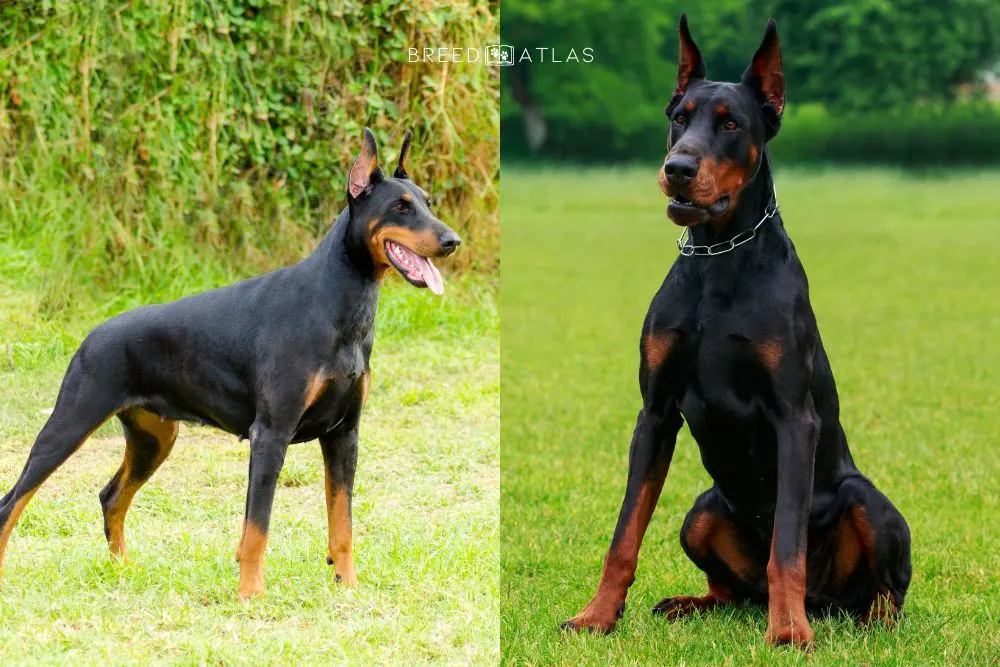
The distinction between American and European Dobermans is in their appearance, temperament, purpose, and build.
The American Doberman Pinscher is characterized as a sleek, elegant show dog with an ideal personality for family life. It exhibits a longer, slimmer physique, emphasizing endurance and grace.
In contrast, the European Dobermann is a larger and more muscular dog, designed for working and protection roles. With a heavier bone structure, it possesses a compact and robust build, emphasizing strength and power.
The European Doberman tends to be bulkier, and its neck is shorter, thicker, and more robust compared to the American variety.
While both types are certainly on the assertive and dominant side, the European Doberman is more fierce and direct than the American one.
Acknowledging distinctions permits enthusiasts and owners to appreciate the exceptional qualities each type obtains for the Doberman breed.
Which Gender Is Right For You?
Whether you have your eye on a black male or a brown female, this highly intelligent, working breed has found use in many different services, but the most popular role they play is a guard dog.
As a pet, Dobies are very affectionate, loving, and loyal to a fault. Easy to train, and can fit in with many different types of families. The Dobermans do require a lot of exercise and regular training but they make wonderful family dogs.
The individual character makes every dog unique, but there are some notable differences between male and female Dobies.
The girls are often more likely to listen to their owners, but less eager to please.
The boys are bulkier, more goofy and playful, and much more tolerant towards strangers. They bond with the whole family, rather than one person, however their playful character translates into easily distractable dogs.
The girls will master potty training sooner, but she will exclusively bond with one person, rather than the whole family.
Never mind the gender of your Dobie, make sure to socialize the dog appropriately and on time. Ensure the dog is sufficiently and continuously trained, and be prepared to offer plenty of different exercises to ensure a happy pup. Whoever you choose as your faithful companion, we wish you good luck. The Doberman is a breed that does not disappoint even the pickiest of the owners.
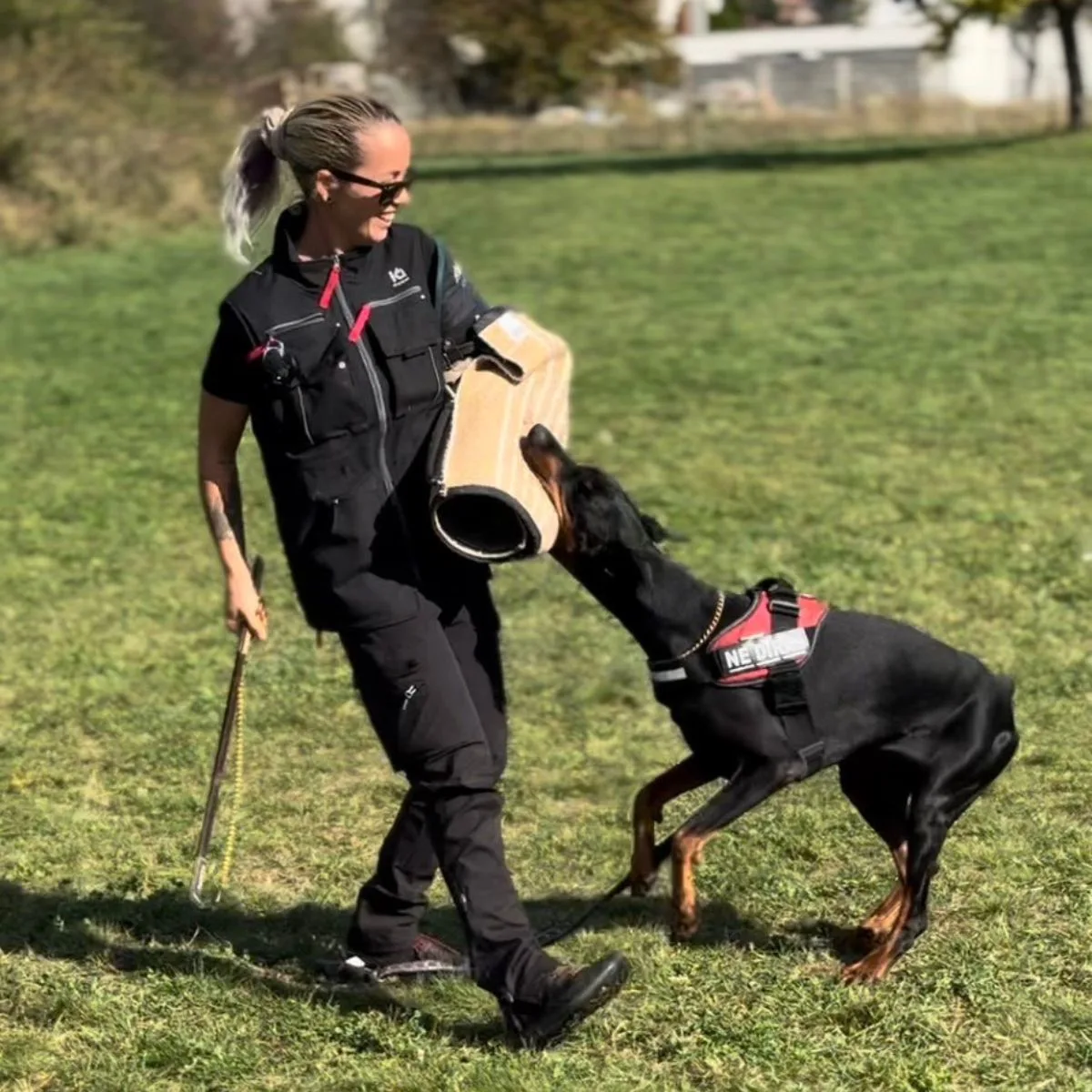
Nandina has been a lifelong dog owner and enthusiast. She shared her home with multiple breeds, including Giant Schnauzers, Cane Corsos, and Huskies. Currently, she is raising a three-year-old rescue and a working-line German Shepherd puppy.
Actively engaged in IGP dog sports for two years, Nandina is a certified instructor for basic obedience and socialization. She works as a trainer in her local dog sports club, and in her spare time, she handicrafts biothane gear for dogs.
